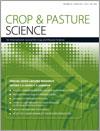Sulfonylurea (SU) herbicides are extensively applied to crops in the cereal-livestock zones of southern Australia. In low rainfall areas with alkaline soils, SU residues can persist over summer and can severely affect sown or regenerating medic pastures. A cohort of early season barrel medics (Medicago truncatula) bred and selected for tolerance to SU herbicide residues were evaluated at multiple field sites over 3 years (year of establishment and subsequent regeneration). Two lines (Z2438 and Z2415) were identified which had dry matter production and seed yield in the establishment year equivalent to their recurrent parent, Caliph, an early maturing, aphid-tolerant, barrel medic cultivar. They also had lower levels of hardseededness than Caliph, enabling them to regenerate in greater numbers in the following year and thus produce more dry matter. The two lines demonstrated good tolerance to simulated SU herbicide residues, producing up to 10 times the dry matter of the SU-intolerant parent Caliph. We anticipate that one or both of the two lines will be commercialised soon, enabling farmers in low rainfall areas with neutral-to-alkaline soils to successfully grow barrel medic pastures in the presence of SU herbicide soil residues resulting from applications to prior crops.
How to translate text using browser tools
10 December 2012
Development of an early season barrel medic (Medicago truncatula Gaertn.) with tolerance to sulfonylurea herbicide residues
D. M. Peck,
J. H. Howie
ACCESS THE FULL ARTICLE

Crop and Pasture Science
Vol. 63 • No. 9
Dec 2012
Vol. 63 • No. 9
Dec 2012
bluegreen aphids (Acyrthosiphon kondoi)
burr medic (Medicago polymorpha)
spotted alfalfa aphid (Therioaphis trifolii)
strand medic (Medicago littoralis)




